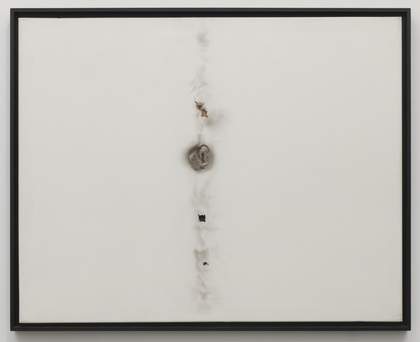
Henk Peeters
Burn Hole 1961
Plastic and wood
800 x 1010 mm
Tate T13407
© Estate of Henk Peeters
Henk Peeters made Burn Hole 1961 at a creative juncture in his career, infusing it with both the painterly, abstract style of art informel and the inexpressive, anti-art gestures of the Nul group.

Henk Peeters
Burn Hole 1961
Plastic and wood
800 x 1010 mm
Tate T13407
© Estate of Henk Peeters
Burn Hole 1961 is a sheet of white PVC stretched over a wooden frame around a metre wide, into which the artist burned a series of holes in a vertical line down the centre. It is one the ‘pyrographies’ (‘fire drawings’) that Peeters began making in 1959, and reflects his membership of the Dutch Nul (Zero) group of artists, active in 1961–5, who rejected individual expression, artistic content and originality.
While most scholars have considered Peeters’s work in light of his role in Nul, this In Focus reads Burn Hole far beyond this context. It looks at its relationship the painterly abstraction of art informel, and at the interplay between abstraction and reality, materiality and immateriality, and authorship and its erasure in the work. Peeters’s use of PVC is discussed in line with its bodily associations – its connection to skin and to sensuality – while a new technical analysis of Burn Hole offers fresh insights into how Peeters made it and how it can be preserved for future display.
Published in October 2019, the project is authored by Michael White (University of York) with a contribution from Carla Flack (Tate) and Emma Richardson (University College London).